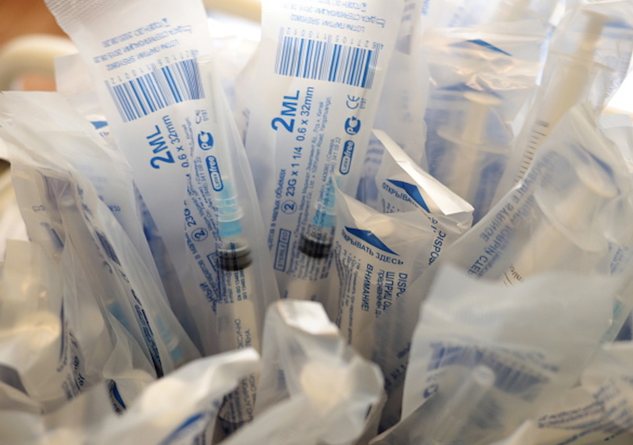The History of Vaccines Shows Us a Lot About Their Future
Photo by Anton NovoderezhkinTASS via Getty Images
Throughout human history we have attempted to defend and heal ourselves from the scourge of infectious disease. Before we even understood what caused pestilences, we were devising ways to avoid them—like the plague.
One such contagion was smallpox, caused by the variola virus. It altered human history not only through its virulence as an epidemic, but also through its later eradication. Smallpox was one of several Orthopoxviruses, like cowpox and monkeypox; a fact that matters insofar as although Smallpox was the only one to infect humans absent of an animal vector, it could serologically interact with the other viruses. Although the disease’s imagery—which included pustular, scabbed pox on the skin of an infected individual—was harrowing, the virus was airborne and therefore primarily spread through inhalation. Although there were two variations of smallpox, one of which caused a much less severe disease course, it was not that minor virus that ravaged civilization.
While recognizing its symptom profile and mode of transmission was instrumental to human survival, it was understanding immunity to it that gave humans—even as early as the first millennium—the impetus to begin fighting it in earnest. If someone became infected with smallpox and survived, they developed lifelong immunity to the disease. This was at least partially determined by the fact that smallpox-infected individuals, once they began to recover, would often be tasked with caring for the newly ill. Others observed that those who had been sick with it once did not become reinfected, even when directly exposed.
In Europe during the 18th century, people began noticing another peculiar thing about “pox” viruses: it seemed that dairy maids had an inexplicable immunity to smallpox, even if they’d never had the disease. What they had been infected with was cowpox—another Orthopoxvirus. Naturally, people began to wonder if they could acquire the apparent immunity of the milkmaids by exposing themselves willfully to cowpox. In fact, this practice dated back thousands of years, but hadn’t yet gone through the ringers of formal scientific inquiry or standardization. As smallpox made its way through not just Europe but the New World, the potential benefits of inoculation through such willful exposure seemed to outweigh the risks—but not everyone was convinced. In the New World in the early 1720s, Rev. Cotton Mather and a physician named Zabdiel Bolston attempted to convince settlers of the importance of smallpox inoculation. Since the exposure was not without risk, and in fact there were people who did get full-blown smallpox as a result of it, the wariness was understandable. But that wariness also turned into something of a panic over inoculation—to the point where Bolston’s house was bombed.
In 1721, a smallpox outbreak in Boston sickened 12,000. Some of the individuals had been inoculated. In what was most certainly he first intentional comparative analysis, Bolston determined that of the people who contracted smallpox naturally, 14 percent died. Of those who contracted it through inoculation, just 2 percent died.
These statistics didn’t convince everyone, but they may have laid a more solid foundation over the next several decades. At least, it did for George Washington: in 1776 smallpox took out half his troops, giving the British an advantage. British troops had been inoculated, as many UK citizens had. Washington quickly, if not reactively rather than proactively, followed suit.
Back in England, a young boy named Edward Jenner had been inoculated, and good thing: he would grow up to develop the world’s first smallpox vaccine. By the 1790s, Jenner had become a country doctor and was an adamant proponent of inoculation, though he desired to better understand how it worked. Having grown up in farming communities, he too was aware that smallpox didn’t tend to befall dairymaids, likely as a result of their cowpox exposure—but again, the why and the how plagued Jenner.
Armed with the inclination to experiment, Jenner then took what was the first scientific approach to vaccine development, beginning with a clinical trial—albeit a very, very small one. He found a local dairymaid with cowpox, took some of the pus from an active pox, and injected the pus into the cut on the arm of one James Phipps—the 8-year-old son of Jenner’s gardener. He allowed a bit of time to pass for the boy’s immune system to become acquainted with the cowpox virus, then—hoping that the boy’s youth and otherwise good health would be on his side—exposed him to smallpox. Much to everyone’s relief (and no doubt Jenner’s delight) Phipps did not become infected.
Although Jenner found the boy’s apparent immunity reassuring, he knew he needed more evidence that his vaccination, as he called it (vacca being the Latin word for cow), actually worked. Over the next several months he attempted to find volunteers in London, but to no avail. Though his recruitment effort was unsuccessful, he left the city with a small supply of his inoculant, just in case. Back home, he would also give it to anyone who asked and found that this strategy for acquiring case studies proved more fruitful. Soon, the demand for the vaccination increased such that he would frequently run out.
His goal, of course, was for it to become widely recognized and ideally compulsory. He wrote up a paper that included several additional case studies—including the vaccination of his own son—and published it in 1789. At best, the medical community was uninterested if not slightly dubious of his claim—predominantly because Jenner still couldn’t explain why the method worked. Microscopic technology of the era lacked the power to see viruses; only their effects could be visualized. At worst, he was subjected to the same distrust and ridicule that Mather and Bolston had in Boston decades before. He carried on with his work, and ever so slowly, vaccination gained traction. It would be 30 years after Jenner’s death before the vaccine would become a requirement in England.
Understanding the mechanism of disease is fundamental to the development of a vaccine. While Jenner didn’t fully understand smallpox’s virology, he still made an invaluable scientific contribution: what we refer to today as a live-attenuated vaccine.
-

-

-

-

-

-

-

-

-

-

-

-

-

-

-

-

-

-

-

-

-

-

-

-

-

-

-

-

-

-

-

-

-

-

-

-

-

-

-

-

 Photo by Dmitry RogulinTASS via Getty Images
Photo by Dmitry RogulinTASS via Getty Images






































